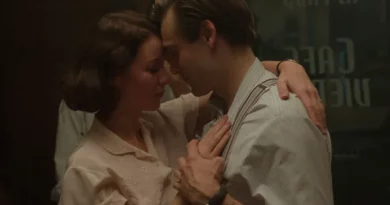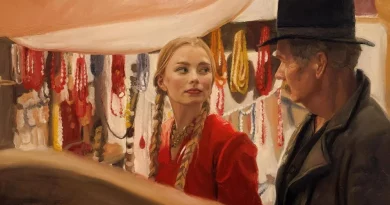Loving Vincent (12A) | Close-Up Film Review

Dir. Hugh Welchman and Dorota Kobiela, UK/Poland, 2017, 93 min
Cast: Douglas Booth, Robert Gulaczyk, Helen McCrory, Jerome Flynn, Chris O’Dowd
Review by Carol Allen
“Loving Vincent” is a groundbreaking combination of live action, animation and artistry, in that the scenes were shot with live actors, then each frame of the film (around 65,000 of them) was hand-painted over in oils in faithful replication of the style of the artist Vincent Van Gogh. The result is visually enthralling as we see Vincent’s paintings and particularly the people in them come to life as the artist himself saw them.
All the characters in the story are people whom Van Gogh painted and the film makers have woven them into a fictional story. The time is 1891, shortly after the Vincent’s suicide. Armand (Booth) is given a letter by his father, Postman Joseph Roulin (O’Dowd), a friend of the late artist, to hand-deliver to Vincent’s brother in Paris. There is no trace of the brother but in the course of his search. as the people whom Armand meets tell him their memories of Vincent, he becomes intrigued by the mystery of the artist’s death. Why did he commit suicide and indeed was it suicide, or was he murdered?
The plot to be honest isn’t that strong. Armand’s quest is more a device on which to hang the visuals, which are so spell binding they hold, indeed grip our attention. It is fascinating the way you can recognise the actors, who play the roles, while are at the same time they have become the people in the portraits brought to life. The best likenesses in terms of being a match with their portrait are Armand himself and Gachet (Flynn), Vincent’s doctor in his final days, though they are all convincing. They include his paint supplier, Pere Tanguy (John Sessions), Gachet’s housekeeper, Louise Chevalier (McCrory), the Doctor’s daughter, Marguerite (Saoirse Ronan), and the Boatman (Aidan Turner) by the river where Vincent often spent his days.
The characters are set in the places where they lived, again painted as seen through Van Gogh’s eyes – the fields, the river and the town, including the famous café at night.
For the flashbacks of these characters’ reminiscences of Vincent, the film uses a black and white photo realism technique, which contrast interestingly with the paintings brought to life and in which Vincent is played by Polish actor Robert Gulaczyk.
This is a beautiful and truly original piece of work and a major achievement, both technically and artistically.



